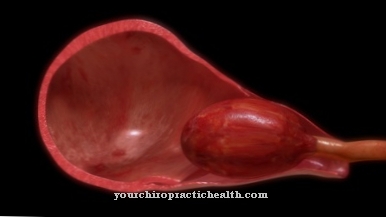The nose warms the air we breathe and gives the inhaled air flow a certain level of humidity in order to adapt it to the climatic conditions of the alveoli. This process is called Conditioning of the breathing air and is the main task of the nasal mucosa. In the case of rhinitis (cold), the conditioning of the breathing air is difficult.
What is the conditioning of the breathing air?

The human nose comprises the outer nose, the inner nose, the paranasal sinuses and the numerous pathways of the anatomical structure. Functionally, the nose is one of the upper respiratory tract and is therefore involved in lung breathing, with which the alveoli of the lungs supply the individual body tissues with vital oxygen.
The throat, into which the windpipe opens, lies behind the nasal cavity. At the level of the fourth and fifth thoracic vertebrae, the windpipe runs into the two main bronchi.In addition to the perception of smell, the nose plays an important role in breathing.
The nose regulates the airflow, does the rough cleaning of the air we breathe and conditions the air we breathe. This conditioning corresponds to an adjustment of temperatures and humidity. The nasal mucosa does this conditioning of the breath. If necessary, the air flow on the mucosal surfaces is heated and humidified. It then continues to flow towards the throat. In this way, the air we breathe receives an ideal temperature and humidity to be processed in the biological environment of the human organism.
Function & task
In humans, lung breathing occurs either through the mouth or the nose. The turbinates are fake cavernous bodies and can change their size significantly. As long as the nose is not blocked or otherwise impaired, it is primarily used for human lung breathing. The nose breathes in up to 10,000 liters of air every day.
Nasal breathing occurs unevenly in a person at rest. Both nostrils are used alternately for breathing. This process corresponds to the so-called nasal cycle. The inhaled air flow is reduced in one of the nostrils and thus enables regeneration of the mucous membrane in the corresponding nostril. After the regeneration of one nostril, the main flow changes unnoticed to the other nostril.
The nose is used both for inhalation and for exhaling air. Each air flow undergoes conditioning during nasal breathing. Extremely cold air, for example, is warmed up and moistened on the surface of the warm nasal mucous membrane. The mucous membrane cools down and dries up to a certain extent. However, when it exhales, it recovers most of its warmth and moisture.
The conditioning of the breathed air corresponds to the conditioning of the inhaled air to the climatic conditions of the lung alveoli. In this way, the nasal mucosa maintains the unimpaired function of the bronchioalveolar mucous membranes. This process is absolutely necessary in the long term, especially in extreme climatic conditions.
Some authors also define the purification of the air flow as nasal conditioning of the breathable air. As the connecting tract between the ambient air and the lower respiratory tract, the nose is the first barrier to foreign matter and particles. The nasal hairs catch coarse particles and the nasal secretion filters fine foreign matter out of the air we breathe. The sustained movement of the cilia permanently transports the nasal secretions towards the throat. Excess secretion is transported to the outside together with the filtered foreign particles as the person sneezes.
In the narrow as well as in the expanded meaning, the conditioning of the air breathed in the nose ensures an approximate ideal of lung breathing and is superior to breathing through the mouth in numerous ways.
You can find your medication here
➔ Medicines for colds and nasal congestionIllnesses & ailments
The conditioning of the breathing air is disturbed in many diseases of the mucous membrane. If the nose is too dry, the humidity of the inhaled air flow can no longer be easily adapted to the climatic conditions of the alveoli, for example.
A dry nose can be a result of a dry runny nose, rhinitis sicca or atrophic rhinopathy. The nasal mucous membrane dries out. Usually the cause of this is the beginning of a cold. However, dry room air or extreme dust exposure can also cause the nasal mucous membranes to dry out. In extreme cases, various bacteria settle on the dry nasal mucous membrane.
In addition to a feeling of dryness in the nose, this phenomenon is often accompanied by itching or a slight burning sensation. Nasal breathing is then restricted as crusts, scabs or crusts form. A dry nose can also cause nosebleeds and poor smell.
A dry nose can no longer moisten the inhaled air, which explains the formation of crusts, scabs and crusts in the nose. This increases the susceptibility of those affected to infection. In principle, the conditioning of the air you breathe can be more difficult with all diseases of the inner nose.
The main symptom of such diseases is always an obstructed nasal breathing. The causes can be bends, spurs, enlarged turbinates, enlarged tonsils, an occlusion of the posterior nostril, nasal polyps or other tumors of the nose.
Rhinitis is also a common disease phenomenon. It is an inflammation of the nasal mucosa. Acute rhinitis occurs, for example, in the case of a cold and is usually triggered by one of 100 subtypes of rhinoviruses. In addition to shivering and exhaustion or head pressure, rhinitis initially has a dry nose. Later, a watery-clear secretion is formed, which in turn becomes a slimy-purulent secretion.
Just like nasal dryness, increased nasal secretion also hinders the conditioning of the breath. Excessive nasal secretion does not necessarily have to be due to rhinoviruses, but can also be due to nasal hyperreactivity.









.jpg)



.jpg)



.jpg)







.jpg)


